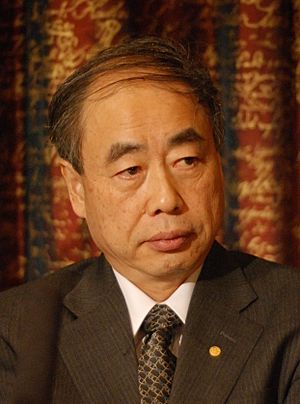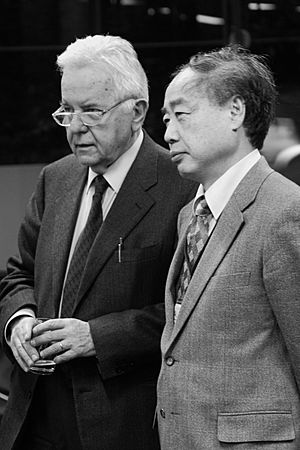Makoto Kobayashi facts for kids
Quick facts for kids
Makoto Kobayashi
|
|
|---|---|
| 小林 誠 | |

Kobayashi in 2008
|
|
| Born | April 7, 1944 |
| Citizenship | Japan |
| Alma mater | Nagoya University |
| Known for | Work on CP violation CKM matrix |
| Awards | Sakurai Prize (1985) Japan Academy Prize (1985) Asahi Prize (1995) High Energy and Particle Physics Prize (2007) Nobel Prize in Physics (2008) |
| Scientific career | |
| Fields | High energy physics (theory) |
| Institutions | Kyoto University High Energy Accelerator Research Organization |
| Doctoral advisor | Shoichi Sakata |
Makoto Kobayashi (小林 誠, Kobayashi Makoto, born April 7, 1944) is a famous Japanese physicist. He is known for his important work on something called "CP-violation." This work helped us understand tiny particles.
In 2008, he won one-fourth of the Nobel Prize in Physics. He received this award for discovering how a "broken symmetry" works. This discovery helped predict that there are at least three types of tiny particles called quarks in nature.
Contents
Early Life and Education
Makoto Kobayashi was born in Nagoya, Japan in 1944. When he was two years old, his father, Hisashi, passed away. Their family home was destroyed during the Bombing of Nagoya. Because of this, they went to live with his mother's family.
One of Makoto's cousins, Toshiki Kaifu, later became the 51st Prime Minister of Japan. Another cousin, Norio Kaifu, became an astronomer. Toshiki Kaifu remembered Makoto as a quiet boy who loved reading difficult books.
Makoto Kobayashi studied at Nagoya University. He graduated from the School of Science in 1967. He then earned his Doctor of Science (DSc) degree in 1972. During his college years, he learned from scientists like Shoichi Sakata.
Discoveries in Physics
After finishing his studies in 1972, Kobayashi became a researcher. He worked on particle physics at Kyoto University. There, he teamed up with his colleague Toshihide Maskawa.
Understanding CP-Violation
Kobayashi and Maskawa worked on explaining "CP-violation." This is a puzzle in physics where tiny particles behave differently than expected. They tried to explain this within the Standard Model of particle physics. The Standard Model describes the basic building blocks of the universe.
Their theory suggested that there must be at least three "generations" of quarks. Quarks are tiny particles that make up protons and neutrons. This idea was proven true four years later. Scientists discovered a new quark called the bottom quark.
The CKM Matrix
In 1973, Kobayashi and Maskawa published an important paper. It was called "CP Violation in the Renormalizable Theory of Weak Interaction." This paper is one of the most referenced in high energy physics.
Their work led to the Cabibbo–Kobayashi–Maskawa matrix. This matrix helps scientists understand how different types of quarks mix together.
Nobel Prize Recognition
For their groundbreaking work, Kobayashi and Maskawa shared half of the 2008 Nobel Prize in Physics. The other half went to Yoichiro Nambu for his own discoveries.
In 2015, bronze statues were set up in Tsukuba City. These statues honor three Nobel laureates, including Makoto Kobayashi.
Professional Journey
Makoto Kobayashi has held many important positions in science.
- In 1972, he became a research associate at Kyoto University.
- He joined the National Laboratory of High Energy Physics (KEK) in 1979. He became a professor there in 1989.
- From 2003 to 2006, he was the Director of the Institute of Particle and Nuclear Studies at KEK.
- In 2006, he became Professor Emeritus of KEK.
- Since 2008, he has been a Distinguished Invited University Professor at Nagoya University.
- He also became a member of the Japan Academy in 2010.
- From 2018 to 2020, he served as the Director of the Kobayashi-Maskawa Institute (KMI) at Nagoya University. He is now Director Emeritus of KMI.
Awards and Honors
Makoto Kobayashi has received many awards for his scientific contributions:
- 1979 – Nishina Memorial Prize
- 1985 – Sakurai Prize
- 1994 – Chunichi Culture Award
- 1995 – Asahi Prize
- 2001 – Person of Cultural Merit
- 2007 – High Energy and Particle Physics Prize by European Physical Society
- 2008 – Nobel Prize in Physics
- 2008 –
 Order of Culture (a high honor in Japan)
Order of Culture (a high honor in Japan) - 2010 – Member of Japan Academy
Personal Life
Makoto Kobayashi was born and grew up in Nagoya, Japan. He married Sachiko Enomoto in 1975, and they had a son named Junichiro. After his first wife passed away, Kobayashi married Emiko Nakayama in 1990. They have a daughter named Yuka.
See also
 In Spanish: Makoto Kobayashi para niños
In Spanish: Makoto Kobayashi para niños
- Progress of Theoretical Physics
- List of Nobel laureates affiliated with Kyoto University
- List of Japanese Nobel laureates


